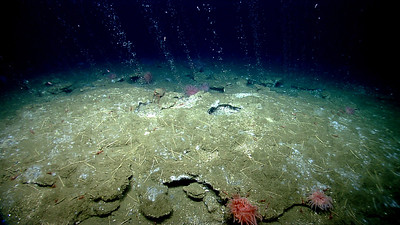Methane seeps are underwater locations around the world where the natural gas you use for cooking or heating, called methane, leaks from the seafloor. These seeps are often found at the transition zones where land meets the ocean, or continental margins. Methane seeps originate from dead plants and animals that were buried under layers of sediment over millions of years, producing organic matter. Under pressure and heat from the Earth’s interior, organic matter breaks down into methane and can leak up through the seafloor into the ocean.
Just as methane can power a stove, it can also provide energy to many different microscopic organisms. Methanotrophic bacteria, or methanotrophs, are microorganisms that use methane as food through a process called aerobic methane oxidation. These bacteria use oxygen to pull energy from methane gas, similar to how we use oxygen to pull energy from our food, and produce carbon dioxide and water in the process, like we do.
When carbon dioxide reacts with water, it forms a weak acid called carbonic acid. Carbonic acid can dissolve the mineral calcium carbonate, which forms limestone and seashells like corals, mussels, clams, and many others. Methanotrophs produce carbon dioxide as a waste product, but scientists don’t know whether they help corrode calcium carbonate in the marine environment. Researchers have tested this in laboratories but not in the marine environment, that is, until now.
A team of researchers from Germany studied how methanotrophs corrode calcium carbonate in active methane seeps at the REGAB Pockmark seep field along the west coast of the Gabon-Congo-Angola continental margin in Africa. They placed 4 limestone cubes 10 centimeters (or about 4 inches) long on top of the seafloor close to active methane seeps, 4 cubes on a mussel bed, and 4 cubes further away, where no methane was leaking. They left the cubes on the ocean floor for 2.5 years before recovering them.
When the researchers retrieved the limestone cubes, they found that those near the methane seep had rough surfaces. They examined these cubes under a microscope and saw tiny holes, known as microborings, that were likely created by microbes. In contrast, when they examined the cubes placed further from the methane leaks, they found no evidence of microborings. They interpreted these differences to suggest that microbes were dissolving limestone at these methane seeps.
To test whether methanotrophs were directly involved in dissolving the limestone, they extracted DNA from the microbial communities living on the limestone cubes. They found DNA from aerobic methane-oxidizing bacteria, specifically members of the order Methylococcales that have not been successfully grown in a laboratory, called the uncultured Hyd24-01 clade. Researchers in the past have reported these microbes at other methane-rich sites, suggesting they could be corroding the limestone.
To corroborate their findings, the researchers also analyzed fatty molecules called lipid biomarkers from the microorganisms at the site. Scientists use lipid biomarkers to identify bacterial groups and what they’re using for energy. They found that the lipid biomarkers from the seafloor sites were consistent with the DNA results. In particular, they found that a lipid from methanotrophs, called n-C16:1ω7, was abundant on the cubes. They concluded that methanotrophs dominated the microbial communities associated with microborings in the limestone cubes.
The team suggested that their results provided real-world evidence that methane-eating bacteria dissolve calcium carbonate rocks in marine methane seeps. They proposed that these bacteria acidify their surroundings by releasing carbon dioxide during methane oxidation. Carbon dioxide released and dissolved in seawater forms carbonic acid, which lowers the pH, dissolves limestone, and contributes to ocean acidification. They recommended that future researchers study the specific mechanisms microbes use to dissolve calcium carbonate and quantify how much microbial erosion contributes to ocean acidification.


